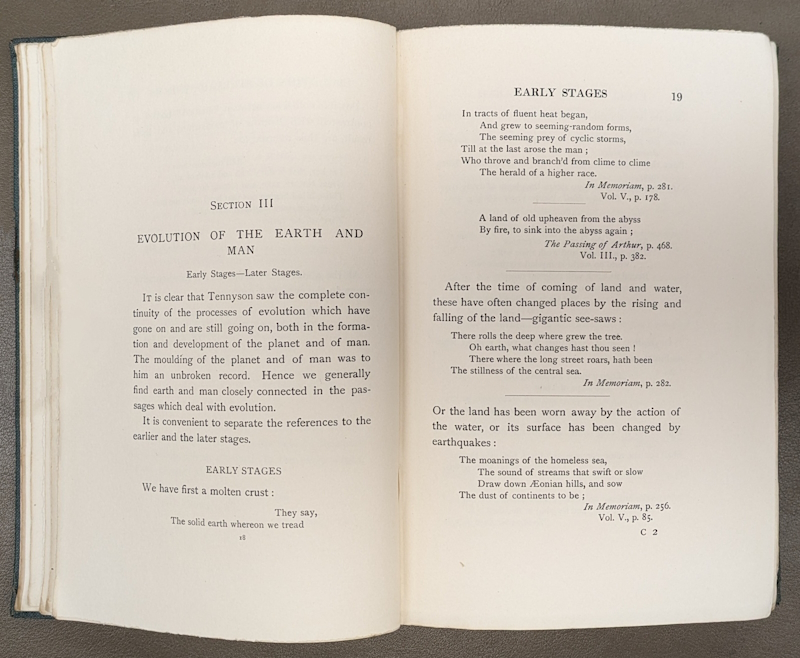Why was the poet Alfred Tennyson elected to the Fellowship of the Royal Society in 1865? Ainsley Vinall investigates.

Having recently joined the Library team at the Royal Society, I’ve been endeavouring to learn more about our many prominent past Fellows. With a background in Art History and English Literature, I was surprised to come across a few names that struck me as distinctly unscientific.
The poet and playwright John Dryden (1631–1700) was one of the Original Fellows, although he was expelled in 1666 for non-payment of dues. The portrait painter and art collector Hugh Howard (1675–1737) was also a Fellow, as was the antiquarian Henry Ellis (1777–1869), best known as chief librarian at the British Museum.
However, the most unexpected Fellow I’ve come across so far is the poet Alfred Tennyson (1809–1892). In searching for an explanation for this incongruous appointment I’ve learned that although Tennyson was better known for his poetry inspired by medieval romances and classical mythology, he was also a close associate of many Royal Society scientists.
 Alfred Tennyson’s election certificate, 1865 (EC/1865/13)
Alfred Tennyson’s election certificate, 1865 (EC/1865/13)
Elected in 1865, Tennyson was described on his certificate of candidature as being ‘Eminent as a Poet and Man of Letters. Attached to Science and anxious to promote its progress.’ However, the exact extent of Tennyson’s enthusiasm for science is somewhat undermined by the fact this phrase is given on the back of the form as an example to use for candidates who are not otherwise qualified through scientific discoveries, publications or inventions.
Indeed, in advance of Tennyson’s election, the astronomer William Parsons, 3rd Earl of Rosse (1800–1867), a previous President of the Royal Society, wrote to assistant secretary Walter White (1811–1893) to share his thoughts on his candidacy. He notes that although Tennyson has ‘not contributed something substantial to the advancement of natural sciences’, it would be better ‘to take the broad view and elect men of great ability and high social position so as to strengthen the Society’. This implies that Tennyson was not appointed for any scientific connection, but because his position as Poet Laureate, the honorary poet of the nation, would enhance the Royal Society’s reputation.
 Letter from William Parsons, 3rd Earl of Rosse to the Royal Society, 12 January 1865 (MS/769/75)
Letter from William Parsons, 3rd Earl of Rosse to the Royal Society, 12 January 1865 (MS/769/75)
Tennyson was in fact well known to some of the Fellows before his election. His brother-in-law Charles Richard Weld (1813–1869), was the assistant secretary and Tennyson would occasionally visit him at Burlington House in the 1850s. On these visits he would often read his poetry aloud and sample the Society’s wine, as well as clambering onto the roof for a smoke, as mentioned in a previous blogpost.
After Tennyson’s death, the astronomer Norman Lockyer FRS (1836–1920) and his daughter Winifred (1873–1934) published an analysis of Tennyson’s poetry entitled Tennyson as a student and poet of nature (1910). According to the preface, the project was supposedly started as early as 1870 by an unnamed writer who had since died. The pair took over the publication and were assisted by a small collection of Fellows and other scientists.
In the introduction, Lockyer recounts an occasion where a group of Fellows were discussing the formation of dust storms only for Tennyson to pipe up with a list of authors he considers to be authorities on the topic. In another anecdote, Tennyson shows a deep interest in the latest attempts to establish the age of the Solar System. As well as indicating that Tennyson was interested in contemporary scientific developments, Lockyer also explains that for many of the Fellows at the time, the close observation of nature seen in his poetry was comparable to the scientific method.
 Pages on evolution from Tennyson as a student and poet of nature (1910)
Pages on evolution from Tennyson as a student and poet of nature (1910)
Throughout the rest of the book, Lockyer tries to show that Tennyson’s poems were a way of disseminating scientific knowledge to the wider public. The following passage from Lucretius (1868) is accompanied by an explanation of how it seems to describe the nebular hypothesis Pierre-Simon Laplace FRS (1749–1827) theorised on the formation of the Solar System:
I saw the flaring atom-streams
And torrents of her myriad universe,
Ruining along the illimitable inane,
Fly on to clash together again, and make
Another and another frame of things
For ever.
Combined with Tennyson’s perceived interest in the age of the Sun, it does seem likely that his reference to ‘atom-streams’ running and clashing together is an allusion to gases and dust in space combining to form stars and planets. However, whether this spread knowledge of the nebular theory to the poem’s readers is another question. This section of the text is, after all, part of a fever-dream brought on by drinking a ‘wicked broth’ brewed by a witch!
Lockyer also quotes a section from In Memoriam A.H.H. (1850) as evidence of Tennyson’s understanding of evolutionary biology. The poem was published almost 10 years before On the origin of species (1859) by Charles Darwin FRS (1809–1882) but is presented as demonstrating a knowledge of pre-Darwinian theories of evolution, such as Vestiges of the natural history of creation (1844) by Robert Chambers:
They say,
The solid earth whereon we tread
In tracts of fluent heat began,
And grew to seeming-random forms,
The seeming prey of cyclic storms,
Till at the last arose the man;
Who throve and branch'd from clime to clime,
The herald of a higher race.
Although the ‘seeming-random forms’ that lead to the ascent of man do resonate with certain aspects of evolution. Tennyson stresses that man is a ‘higher race’, implying some spiritual aspect that elevates humankind above our evolutionary neighbours. Tennyson, who was brought up by a clergyman father in a faithful Christian household, found evolution a troubling concept that had far-reaching implications for the purpose of human life.
In Memoriam A.H.H. is an elegy for Tennyson’s close friend Arthur Henry Hallam (1811–1833) and hence evolutionary theory is used as part of his struggle to understand the world in the face of grief. Although the poem does show Tennyson is aware of Chambers’s work, Lockyer chooses not to mention that it is ultimately an attempt by Tennyson to rationalise his knowledge of science with his complicated religious beliefs and tragic personal experiences.
 Alfred Tennyson photographed by William Jeffrey, 1865 (IM/004520)
Alfred Tennyson photographed by William Jeffrey, 1865 (IM/004520)
As Lockyer moves on to analyse how Tennyson’s musings on nature demonstrate his scientific attitude to observation, the examples become a little more tenuous. The line ‘the live green has kindled into flowers’ from Gareth and Lynette (1872) is used to demonstrate a scientific affinity through understanding the changing of the seasons. A familiarity with the notion that the Moon causes tides is demonstrated by the line ‘Ask me no more: the moon may draw the sea’ in The Princess (1847), although this was relatively well known by the nineteenth century.
A quick look at Lockyer’s certificate of election from 1869 shows that Tennyson was in fact one of the Fellows that recommended him, so perhaps this defence of Tennyson as a ‘Student and Poet of Nature’ is a gesture of gratitude towards an old friend and a man who seemed at home in scientific circles. The truth is that we don’t really know how Tennyson himself felt about being an FRS – or perhaps it is telling that it isn’t mentioned once in either his collected letters or the account of his life by his son Hallam Tennyson (1852–1928).

